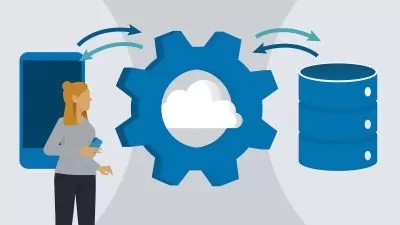Android 14 Internals - customize Cuttlefish in the cloud
Gil Zhaiek
55:06
Description
Build and run Android 14 in the cloud, create system services, solve SELinux errors and debug native crashes.
What You'll Learn?
- Understand Android OS Architecture and control Linux kernel drivers
- Develop a C++ service and make it persistent with an rc file
- Build a Kotlin application with system control UI
- Use AIDL for HAL communication be in line to AOSP design patterns and the CTS
- Learn how to solve SELinux avc denied errors
Who is this for?
What You Need to Know?
More details
DescriptionThis comprehensive course is designed to guide participants through the intricacies of setting up a development environment on Ubuntu 20.04 within Google Cloud, diving deep into the Android Open Source Project (AOSP), and mastering the art of Android platform development.
Through a structured series of lectures and labs, learners will embark on a journey that covers a broad spectrum of topics from VM setup and source code compilation to advanced security and debugging techniques.
Section 1 lays the foundational knowledge required to navigate Google Cloud's compute engine, install the gcloud CLI, and create a VMX-enabled Ubuntu VM, ensuring students are well-prepared for Android platform development.
Section 2 progresses to downloading and building the Android 14 source code. Participants will learn how to bring the Cuttlefish device to life, providing a practical environment for testing and development.
In Section 3, the course shifts focus to transforming Ubuntu Server into a Desktop environment and installing ASfP, equipping learners with the tools necessary for Android platform development.
Section 4 introduces essential tools like the 'hmm' command and adb, enhancing the learners’ ability to interact with and control Android devices and environments effectively.
Security basics are demystified in Section 5, where participants explore user IDs, discretionary and mandatory access control, and how Android secures application data and processes, providing a solid understanding of Android's security model.
Section 6 delves into images and partitions of Android, revealing the complexities of system updates, and partition management.
Sections 7 through 14 consist of hands-on labs ranging from creating a CPU HAL interface with AIDL, developing service daemons, setting correct SELinux permissions, to creating and registering the CPU service implementation. Each lab is meticulously designed to reinforce learning, encourage exploration, and develop a thorough understanding of Android platform development.
Moreover, the labs tackles debugging tools and strategies, including forcing crashes and using llvm-addr2line, as well as debugging native services with lldb, preparing students to troubleshoot and optimize Android platform applications and services efficiently.
By the end of this course, participants will have gained not only theoretical knowledge but also practical experience in Android platform development, security models, debugging, and application deployment, enabling them to contribute to the Android ecosystem or undertake custom Android platform projects with confidence.
Who this course is for:
- Anyone wanting to understand the Android OS for work, hobby or to gain experience
This comprehensive course is designed to guide participants through the intricacies of setting up a development environment on Ubuntu 20.04 within Google Cloud, diving deep into the Android Open Source Project (AOSP), and mastering the art of Android platform development.
Through a structured series of lectures and labs, learners will embark on a journey that covers a broad spectrum of topics from VM setup and source code compilation to advanced security and debugging techniques.
Section 1 lays the foundational knowledge required to navigate Google Cloud's compute engine, install the gcloud CLI, and create a VMX-enabled Ubuntu VM, ensuring students are well-prepared for Android platform development.
Section 2 progresses to downloading and building the Android 14 source code. Participants will learn how to bring the Cuttlefish device to life, providing a practical environment for testing and development.
In Section 3, the course shifts focus to transforming Ubuntu Server into a Desktop environment and installing ASfP, equipping learners with the tools necessary for Android platform development.
Section 4 introduces essential tools like the 'hmm' command and adb, enhancing the learners’ ability to interact with and control Android devices and environments effectively.
Security basics are demystified in Section 5, where participants explore user IDs, discretionary and mandatory access control, and how Android secures application data and processes, providing a solid understanding of Android's security model.
Section 6 delves into images and partitions of Android, revealing the complexities of system updates, and partition management.
Sections 7 through 14 consist of hands-on labs ranging from creating a CPU HAL interface with AIDL, developing service daemons, setting correct SELinux permissions, to creating and registering the CPU service implementation. Each lab is meticulously designed to reinforce learning, encourage exploration, and develop a thorough understanding of Android platform development.
Moreover, the labs tackles debugging tools and strategies, including forcing crashes and using llvm-addr2line, as well as debugging native services with lldb, preparing students to troubleshoot and optimize Android platform applications and services efficiently.
By the end of this course, participants will have gained not only theoretical knowledge but also practical experience in Android platform development, security models, debugging, and application deployment, enabling them to contribute to the Android ecosystem or undertake custom Android platform projects with confidence.
Who this course is for:
- Anyone wanting to understand the Android OS for work, hobby or to gain experience
User Reviews
Rating
Gil Zhaiek
Instructor's Courses
Udemy
View courses Udemy- language english
- Training sessions 17
- duration 55:06
- Release Date 2024/04/27











